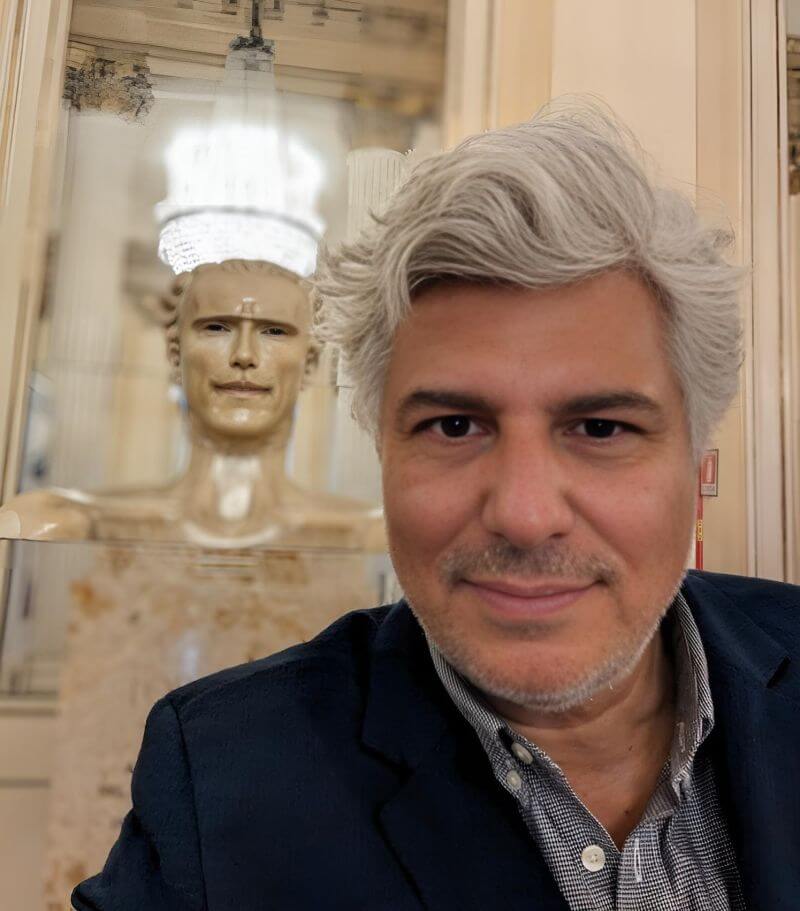11/26/21 – I heard a lecture on YouTube today that suggested that “art’s value is not in the item, it’s in what we assign to it.” – It wasn’t even in the context of discussing Non Fungible Tokens of bored apes, but that would certainly apply.
So, I searched to find the quote by Sondheim, the one that goes, “Art isn’t easy…” Sondheim believed in craft. Not lightning striking and thinking what you just put down on paper is somehow inspired art. He believed in the difficulty of decisions being made to eventually arrive at great art. I read an interview where he discussed that George Seurat made 500,000 dabs of paint to create A Sunday Afternoon on the Island of La Grande Jatte, the painting that inspired his musical “A Sunday In The Park With George” and as he states, “That’s 500,000 decisions.”
When I hit the back button, the very next thing I saw was the announcement of his death today. How interesting for me to be seeking his guidance on the day he died. He has given and in fact, communicated to me so many fun and wonderful experiences through his art.
I think of Tolstoy’s writings on art. It always agreed with me. Art as communication. Art as the purposeful expression of the creator’s feelings conveyed to the recipient and the recipient then recreates the feelings or emotion within oneself.
11/27/21 – The articles are pouring in about the life of Stephen Sondheim.
Sometimes, when at a table with a group, I would ask people to name a living genius? Responses I would get included the chessmasters Magnus Carlsen or Garry Kasporov. I would hear Stephen Hawking a lot when he was alive. I would also hear Yo-Yo Ma, Bill Gates, Larry Paige, Elon Musk and Oprah Winfrey. Then I would get Michael Jordan too. I alway said Stephen Sondheim.
The thing that stands out for me, among many, many things he did on a genius level, was his incredible ability to write a song about a character’s complicated inner monologue. Show after show, you can pick out the song where the character is in a debate, a dilemma, uncertain about their choice or how to live or love, whether to be vengeful or hurt, resilient or sentimental. He knew how to probe the inner dialogue so deeply and authentically that it is both magical and believable. I don’t think anyone did this better than he did.
Sondheim was a leader, a visionary, unafraid to push boundaries in musical theater and then push some more.
This week, Steven Sondheim passed and it has led me to be a little more introspective than usual. I reflected about what his music and his accomplishments have meant to me. Among his many talents, composer, lyricist, and visionary, there is one particular trait that I believe lies at the core of all of his talent. His relentless motivation.
In interview after interview, in biographies and essays about Sondheim’s life, there is this river that runs through him of the need to push musical theater past it’s limits. Always pushing for new ways of presenting stories and music, never happy with presenting a show in the norms of the time or status quo. He truly believed that unless he pushed the genre of musical theater, it may die. Keep Moving On.
His motivation, I believe, was his reverence for the Theater. A respect for what had preceded him and his responsibility to do what he could to keep it moving forward. To take risks, even if a show might fail. The idea was to keep moving forward. He has said later in life in an interview with host James Lipton in an episode of “’Inside The Actors Studio” when asked what profession he would most enjoy if not in the career he was in, I remember he immediately said, “Teacher.” This is very apparent in the few masterclasses of Sondheim coaching singers on YouTube. Each of them is a jewel of teaching and theatrical singing methods.
My Journey With Sondheim

In 1979 on a school trip to Broadway, my young teenage self sat in the Uris Theater, not knowing anything about what was to take place before me. The house went dark, a solo organist began to play an ominous intro and then a shriek, no, an almost human scream of a factory whistle riveted everyone’s attention to the stage. Suddenly, all in my row felt their eyes grow wider. What is happening? A Londoner began to sing:
Attend the tale of Sweeney Todd
His skin was pale and his eye was odd
He shaved the faces of gentlemen
Who never thereafter were heard of again
I attended the tale of Sweeny Todd, The Demon Barber of Fleet Street, the original production of Stephen Sondheim’s masterpiece and I knew I was witnessing something incredibly rare. The music, the lyrics, the outrageous storyline, the love songs, and vengeance personified. There were so many emotions, the sets, the precision of the orchestra in the pit, the costumes, the humor of a mass murdering duo. At the time I didn’t know exactly how to take it all in, but I knew it was amazing. I have attended the tale over several different incarnations of the show through the years and all fresh takes on the original. All fantastic in their own way.
Six years later in college I was playing lead trumpet in the pit orchestra for Hofstra University’s production of Merrily We Roll Along, Sondheim’s legendary Broadway flop. I didn’t understand why it closed so quickly and was his biggest failure. I liked it. The world liked it later.
Sondheim often tells the story of how at a young age, his parent’s divorce devastated him and he would seek refuge at his best friend’s home. His best friend’s father was Oscar Hammerstein II. He said that he was so enamored and influenced by Hammerstein that if Hammerstein happened to be a geologist, he would have been a geologist. How lucky we are that Hammerstein was not a geologist! But it does speak to how Sondheim defines his early motivation. He was thirsty for guidance and Hammerstein supplied it.
When Stephen Said Farewell
Stephen Sondheim played piano and sang at the memorial service of the famous director, choreographer and his friend, Michael Bennett. He died in 1987 at 44, from AIDS-related lymphoma. Sondheim performed “Move On” from his musical “Sunday In The Park With George.”
In the show, Dot, the artist’s former lover and muse, appears as an epiphany to visit George. The song is the show’s eleven o’clock number and reveals to George through introspection that he need not dwell, rather to progress and move on. Motivational lyrics by Sondheim… two great examples:
Stop worrying where you’re going
Move on
If you can know where you’re going
You’ve gone
Just keep moving on.
I chose, and my world was shaken
So what?
The choice may have been mistaken
The choosing was not.
You have to move on.
Plus, this incredibly autobiographical lyric for Sondheim:
Stop worrying if your vision
Is new.
Let others make that decision —
They usually do.
You keep moving on.
I viewed the Bernadette Peters / Mandy Patinkin version this week a few times when I thought about Sondheim’s passing. He was an arts leader with a passionate responsibility for advancing the genre of Musical Theatre and protecting it from its own demise.
______
“Move On” – Bernadette Peters and Mandy Patinkin
“Move On” – sung by Stephen Sondheim at the Memorial Service of Michael Bennett.











